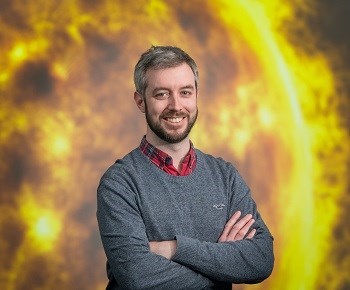ACADEMIA
Northumbria physicist Smith wins half a million pounds to develop AI for predicting space weather

A Northumbria University physicist has been awarded more than half a million pounds to develop artificial intelligence which will protect the Earth from devastating space storms.
Activity from the Sun such as solar eruptions, known as Coronal Mass Ejections, results in plasma being fired toward Earth at supersonic speeds, which can result in serious disruption to power and communication systems.
With our increasing reliance on technology, solar storms pose a serious threat to our everyday lives, leading to severe space weather being added to the UK National Risk Assessment for the first time in 2011.
Northumbria’s Dr. Andy Smith has recently been awarded a Research Fellowship from the Natural Environment Research Council (NERC) to explore how physics-inspired machine learning could be used to forecast space weather more accurately and predict serious space storms.
During the Next Generation, Physics-Inspired AI for Space Weather Forecasting project, Dr. Smith and his team will analyze huge amounts of data from satellites and space missions over the last 20 years to gain a better understanding of the conditions under which storms are likely to occur.
They will then develop cutting-edge supercomputer models which will use the data gathered to predict when such storms could occur in the future, forecasting phenomena such as the northern lights, or aurora.
As Dr. Smith explains: “One of the primary ways in which space weather can impact society is through an unexpected surge of energy in power networks and pipelines on the ground.
“These surges can accelerate the aging of power systems, or even lead to the immediate failure of components such as power transformers, leading to a complete loss of power.
“This research will take a leap forward in understanding and predicting when we are at risk of suffering from these surges, caused by rapid changes in the Earth's magnetic field.”
Throughout history, there have been several examples of serious geomagnetic space storms. In March 1989 the Canadian city of Quebec lost power for over nine hours following a huge solar storm, resulting in auroras or ‘polar lights’ being visible as far south as Texas and Florida.
And in 2003 the Halloween solar storms, named because they occurred at the end of October, affected satellite-based systems and communications, with aircraft being advised to avoid high altitudes near the polar regions and an hour-long power outage in Sweden.
But the most intense geomagnetic storm ever recorded was the 1859 Carrington Event, which resulted in strong auroral displays visible around the world, as well as fires in multiple telegraph stations. The solar flare connected with the event was observed and recorded independently by British astronomers Richard Christopher Carrington and Richard Hodgson.
As Dr. Smith explains: “Our reliance on electrical power networks means that a storm on the same scale as the Carrington Event would have devastating consequences today, making an accurate forecasting system even more essential.
“The technology we are developing through this project could protect the Earth from the impact of geomagnetic storms as we could predict when such events would occur, allowing us to prepare.
“For example, in the UK this would be coordinated through the Met Office which would inform the National Grid, which would in turn activate plans to protect our power grid.
“It’s not a case of if the Earth will be hit by a serious space weather event, it’s a case of when – and this physics-inspired artificial intelligence system will allow us to predict such an event and protect ourselves from it.”
Dr. Smith is a member of Northumbria University’s Solar and Space Physics research group. This is the latest in a series of high-profile grants awarded to academics at the University studying the impact of space weather on the Earth.
In 2021 a team led by Professor Clare Watt was awarded £400,000 from the Science and Technology Facilities Council (STFC) to develop new methods of predicting conditions in the radiation belts above the Earth, providing safer conditions for satellites and spacecraft.
Dr. Shaun Bloomfield led Northumbria's involvement in the Space Weather Empirical Ensemble Package (SWEEP) project, commissioned by the Met Office to develop an improved system for forecasting solar storms. And he was also a Project Scientist in the FLARECAST project, which involved scientists from six countries developing a service to predict the occurrence of solar flares.
Dr. Richard Morton is leading the £ 1.2 million Revealing the Pattern of Solar Alfvénic Waves (RiPSAW) project, having been awarded a prestigious UKRI Future Leader Fellowship in 2020. The project involves using advanced mathematical techniques and cutting-edge computer simulations to create models of the Sun which will provide new insight into the physics behind its activity.
Professor James McLaughlin leads Northumbria University’s Solar and Space Physics research group and is the Principal Investigator of the £ 1.3 million NUdata STFC Centre for Doctoral Training in Data Intensive Science.
He said: “Northumbria University plays multiple, key roles in the UK’s endeavor to understand the scientific and technical aspects of Space Weather. And via our Centre for Doctoral Training in Data Intensive Science, Northumbria is training the next generation of data science and artificial intelligence specialists. Dr. Smith’s new project complements and enhances both these areas of University strength.”

